The Scottish Shelf Model. Part 1: Shelf-Wide Domain
Part 1 of the hydrodynamic model developed for Scottish waters.
4 Marine Energy Resources
4.1 Introduction
The requirement is to make an assessment of the tidal energy resources. This was to include standard parameters of energy resources, for example, mean peak spring tidal current and mean power density for tidal stream areas. Marine Scotland intends to use the data generated for these plots within ArcGIS.
4.2 Tidal energy resources
There are two main approaches to estimating tidal energy resources - either to select a representative tidal period (typically a "mean" spring tide) to analyse, or to perform harmonic analysis on a longer time series and use the constituents derived to compute representative values. The former approach is outlined in the EMEC standards document "Assessment of Tidal Energy Resource" ( www.emec.org.uk), whilst the latter approach was used for the ABPMer / NOC Atlas of Marine Energy Resources ( www.renewables-atlas.info).
In this exercise, it was decided to follow the second approach, performing harmonic analysis of a longer time series. It is difficult to select an "average" tide that is representative, as these will vary throughout the year and between years and may not give representative currents across the whole Scottish Shelf.
Having decided on the methodology, FVCOM was run for a whole year. The tidal forcing used was derived from the TOPEX satellite data as in previous runs, but with nodal factors excluded to give an average tidal year. The results from this run were then analysed, and this analysis is described in more detail below.
The software package T_TIDE was once again used to analyse time series to obtain harmonic constituents, given FVCOM contains no in-built code to perform this function. Due to the amount of processing needed, harmonic constituents were only computed for relevant Scottish Waters.
The data for the maps of tidal energy resources has been prepared using Matlab to manipulate FVCOM output in NETCDF files. ArcGIS shape files can be produced by importing xyz files of this data into ArcCatalog, from whence it can be transformed to shape file format.
4.2.1 Mean Spring / Neap Tidal Range
Mean spring tidal ranges were computed directly from the two principal semi-diurnal components M 2 and S 2 using the formula 2 x (Amplitude M 2 + Amplitude S 2). Values for these constituents were obtained from a harmonic analysis of one year's worth of data using tidal forcing without nodal corrections (considered to be an average tidal year). These harmonic components control the timing of the spring-neap cycle, and their combination is considered to give a good measure of average spring (and neap) tides. The data were also used to calculate the mean neap tidal range as 2 x (Amplitude M 2 - Amplitude S 2). A map of the mean spring results is shown in Figure 4-1, and by way of comparison, the equivalent tidal range from the ABPMer / NOC Atlas of Marine Energy Resources ( http://www.renewables-atlas.info/) is shown in Figure 4-2. The corresponding plots for mean neap tidal range are shown in Figures 4-3 and 4-4.
As can been seen from Figure 4-1 and 4-2, there is good agreement between the two sets of mean spring tidal range results. There are some minor differences around the amphidromic point to the NE of Ireland. This is perhaps to be expected given that we are comparing results from a structured grid at 1.8km resolution with an unstructured grid with a typical mesh resolution of 750m in the vicinity of north-east Ireland, and that the amphidromic points are likely to be sensitive to the model setup. Some of the difference may also be due to differences in the projections used for the two plots. Also apparent is the difference in tidal range in the upper Solway Estuary and this is likely to be due to bathymetry differences between the two models. The structured model for the ABPMer / NOC Atlas uses a minimum depth throughout the upper estuary, in order to avoid drying out, whereas the FVCOM model uses more accurate bathymetry data. This identifies the main channel but is typically shallower in the upper estuary, leading to the differences in model results. The same feature is seen in the mean neap tidal range plots (Figures 4-3 and 4-4), which otherwise show excellent agreement.
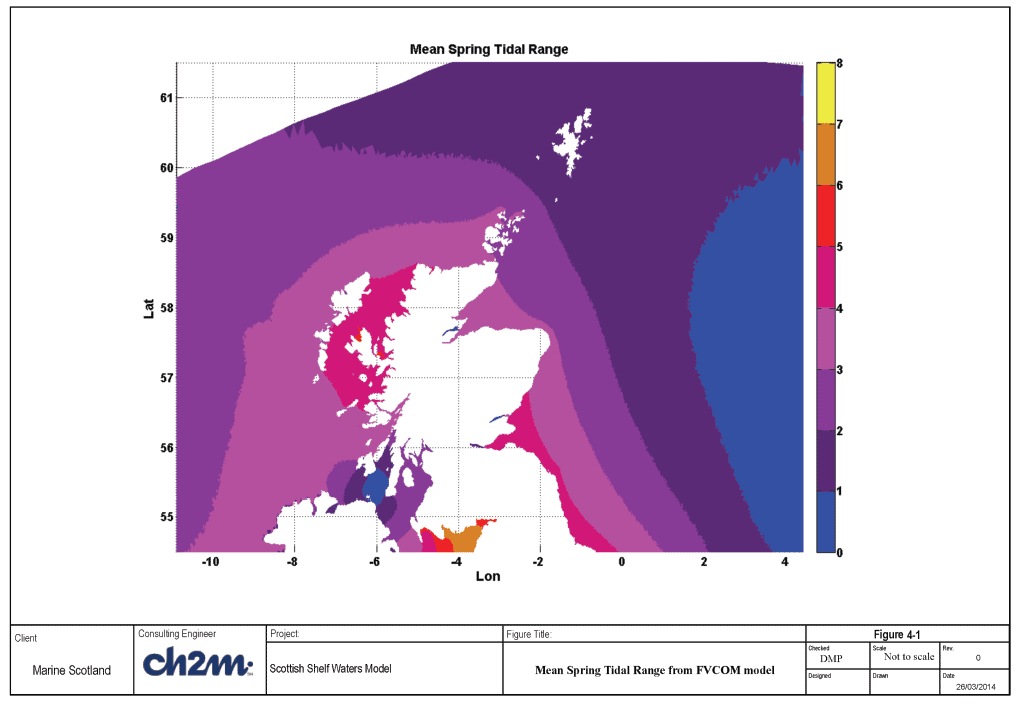
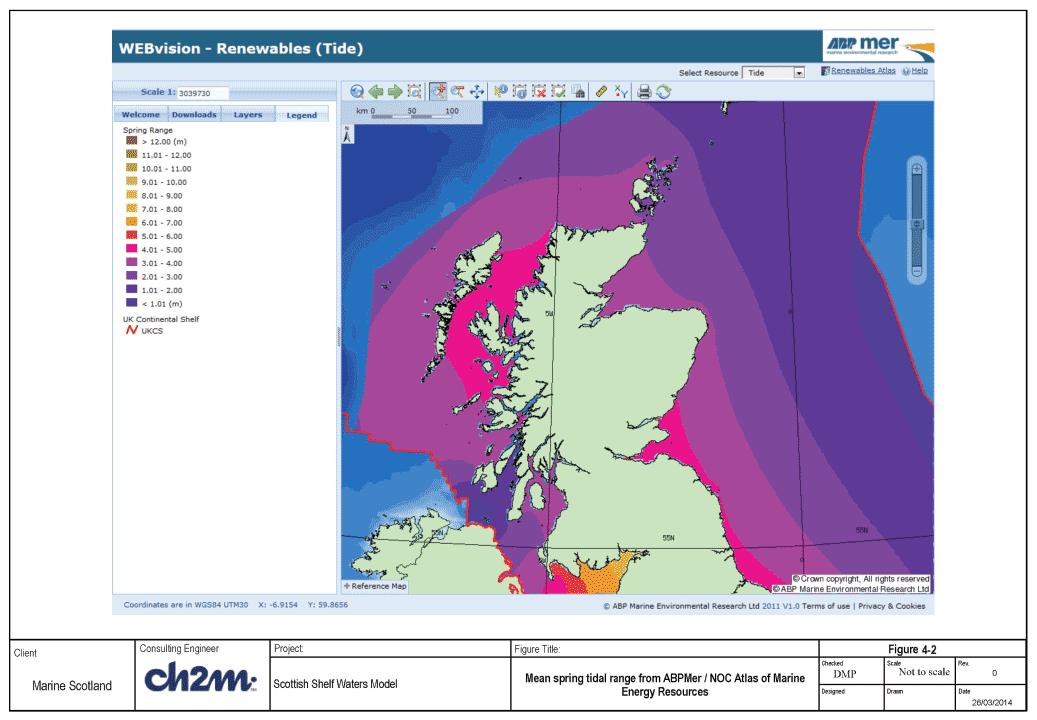
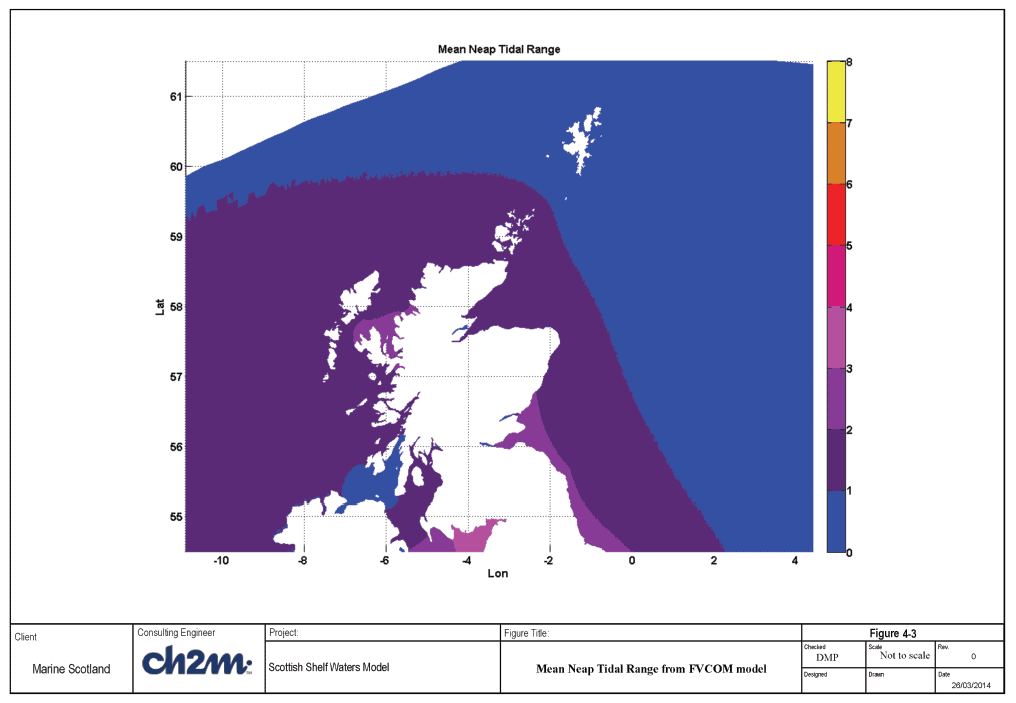
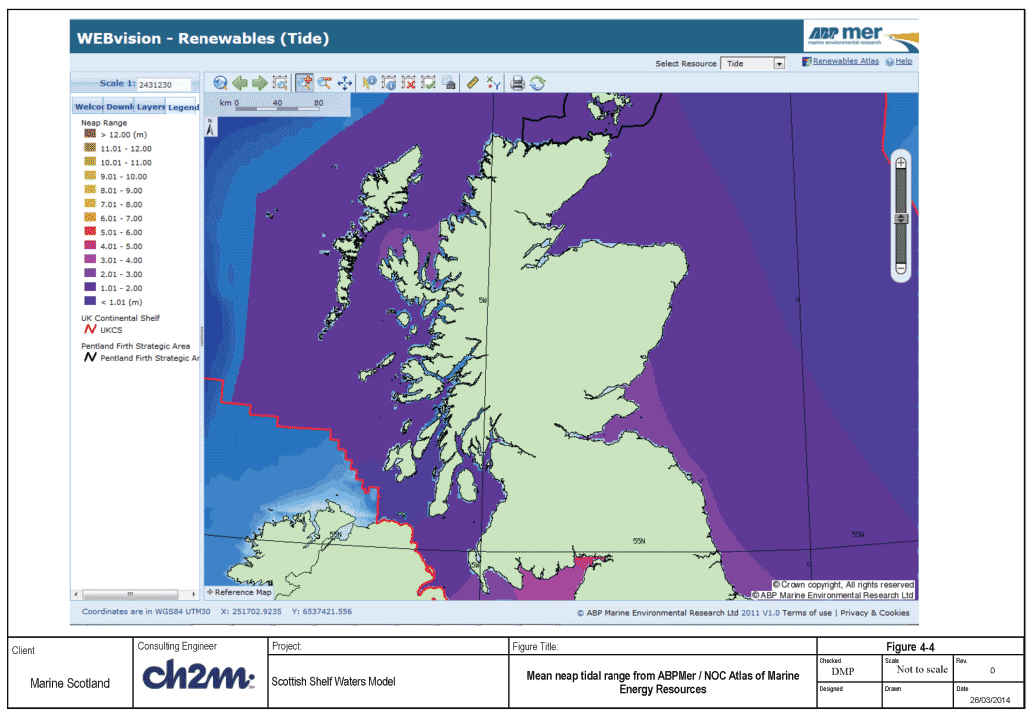
4.2.2 Mean Peak Spring / Neap Current
Mean peak current speeds have been calculated from a harmonic analysis of a year's worth of tidal velocities. In line with the methodology used for the ABPMer / NOC Atlas, a mid-depth velocity was used for the calculations. The east and north components of velocity were analysed using T_TIDE to give the M 2 and S 2 amplitudes and phases. These were in turn analysed to give the semi-major axis amplitudes for each ellipse. The mean peak spring current was then computed as (amplitude semi-major axis M 2 + amplitude semi-major axis S 2). The mean neap spring current was computed as (amplitude semi-major axis M 2 - amplitude semi-major axis S 2). A map of the results for mean spring current is shown in Figure 4-5, and by way of comparison, the equivalent tidal range from the ABPMer / NOC Atlas of Marine Energy Resources is shown in Figure 4-6. Corresponding plots for the mean neap current are shown in Figures 4-7 and 4-8.
As can been seen from Figures 4-5 and 4-6, there is good agreement between the two sets of results for mean peak spring current, particularly in the important Pentland Firth Strategic Area. There are some minor differences apparent in the Solway Firth, but these probably follow from the bathymetry (and hence tidal range) differences between the two models discussed in the previous section. The increased spatial resolution of the FVCOM model (~750m compared to 1.8km for the ABPMer / NOC model) can be seen to resolve more current detail in some coastal areas, especially around Jura, correlating well with observations. The plots for mean neap current (Figures 4-7 and 4-8) also show a similar pattern (for the same reasons), with additional being apparent around Jura in the FVCOM model results.
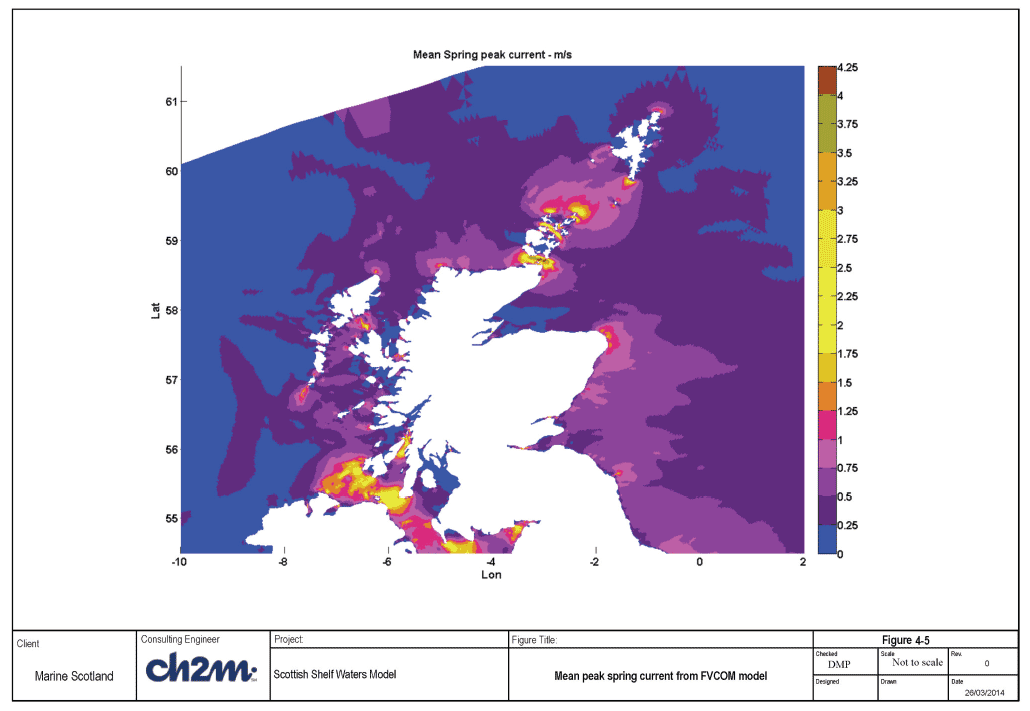
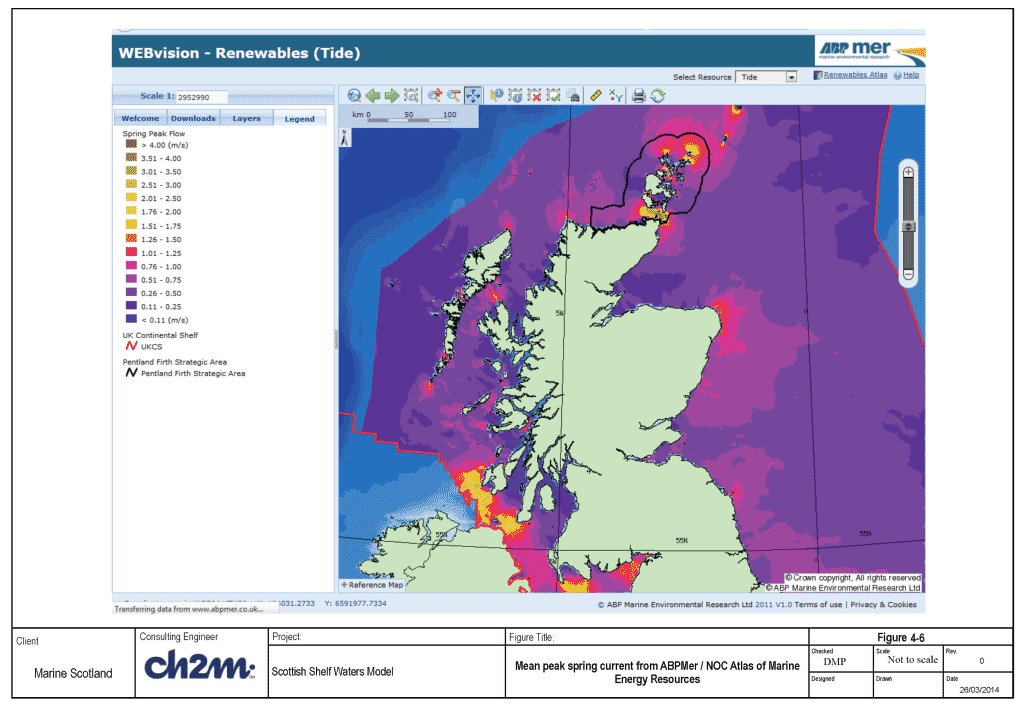
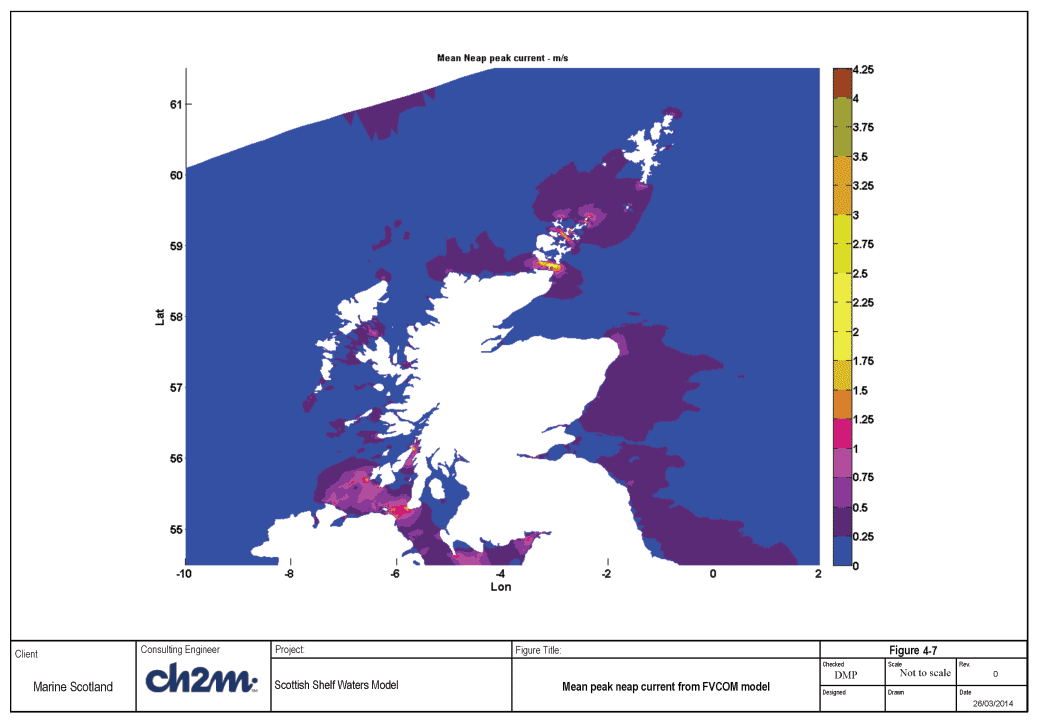
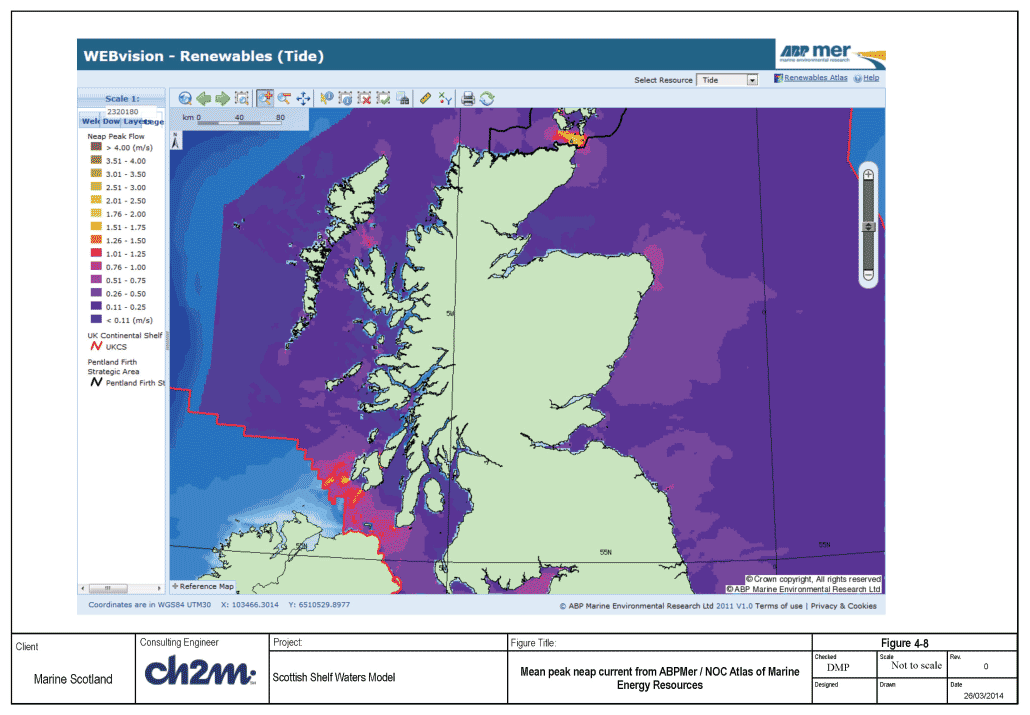
4.2.3 Mean Tidal Stream Power Density
The mean tidal stream power density is the kinetic energy in the tidal flows (per unit cross-sectional area) averaged over the time period, which in this exercise was a whole year. As tidal energy results were computed by harmonic analysis of long time series (as discussed earlier), only the mean annual power density was calculated.
A mid-depth velocity was used as in the previous section, with the mean power density being given by 0.5 x ρ <U 3>. The density ρ was taken as 1027 kg/m 3, and the chevrons indicate that it is the cube of the mid-depth speed that is averaged over the whole year. A map of the results is shown in Figure 4-9, and by way of comparison, the equivalent tidal range from the ABPMer / NOC Atlas of Marine Energy Resources is shown in Figure 4-10.
As can be seen from the plots, the FVCOM model is correctly identifying both the location and magnitude of the maximum annual average power. The unstructured grid mesh with a minimum resolution of 750m has resolved additional detail around Jura, and around headlands between the Mull of Kintyre and Ireland. There is a slight difference observed off the tip of Islay which is probably due to differences in model resolution and bathymetry.
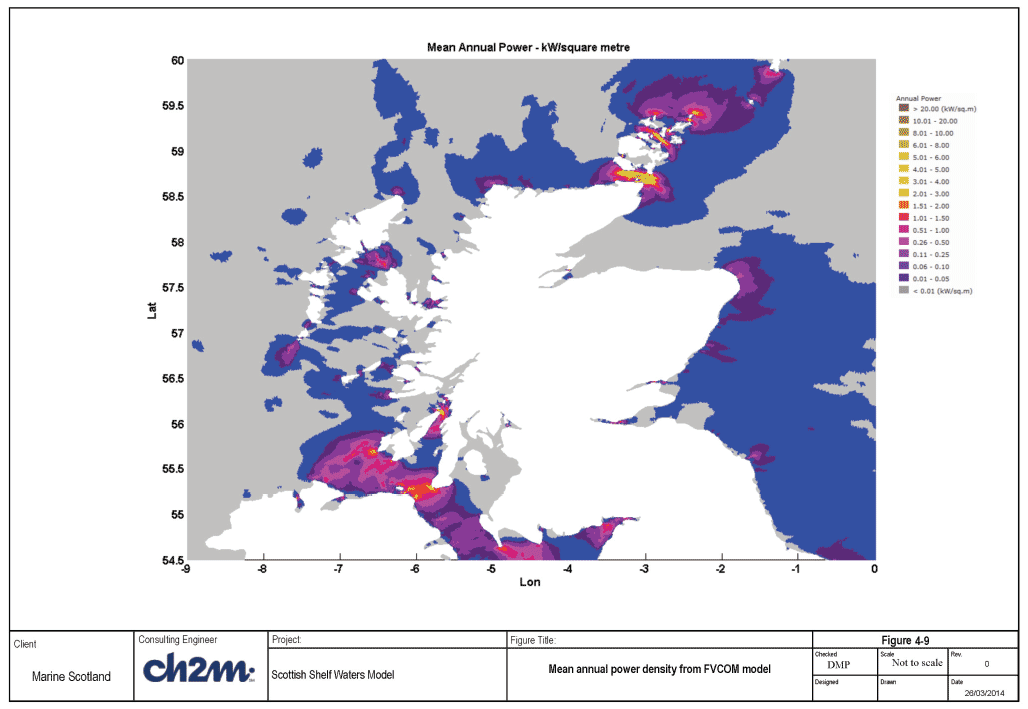
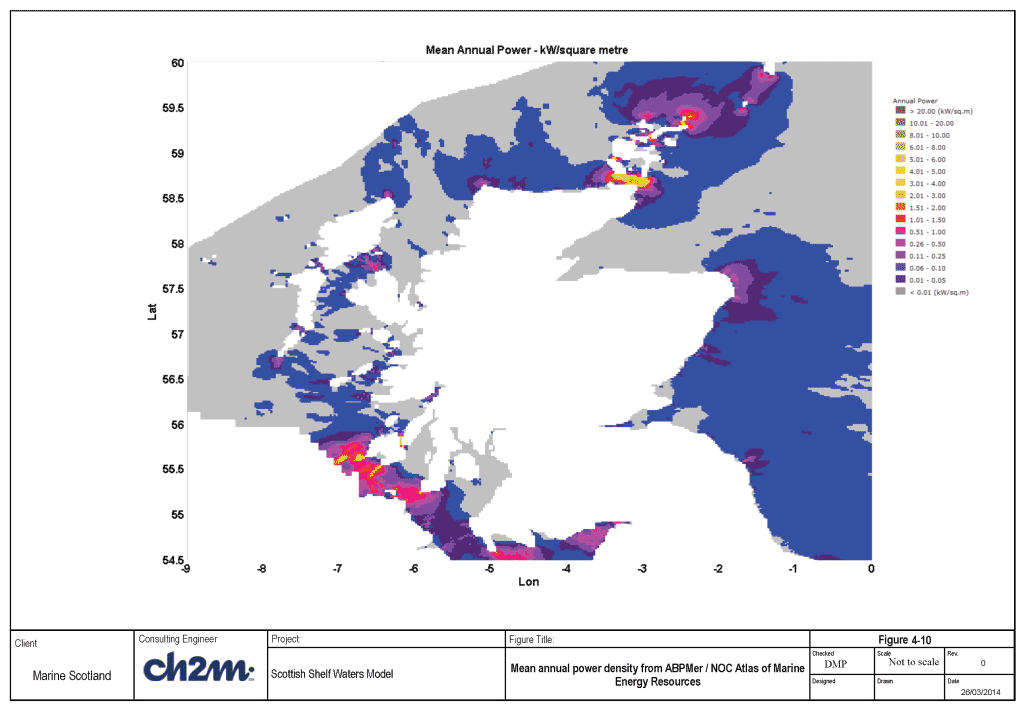
4.3 Approaches for assessing impacts of extracting tidal stream energy
There are a number of stakeholders requiring detail on the impacts of extracting tidal stream energy. Developers, for example, need to know how much energy their device will actually generate, as this is crucial to the viability of their business. Regulators, by contrast, want to understand the impacts of tidal devices on waves, sediment transport, tidal currents, mixing in the water column and marine animals. Regulators also need to know the total impact of multiple farms of devices, and potentially the conjunctive impact of different categories of (farms of) devices such as wave and tidal stream energy convertors.
These differing and complex needs cannot be met by simple analytical (mathematical) models, and so there is a need to represent devices in either 2-D or 3-D numerical models. Only tidal stream devices are considered here. Whilst (3-D) FVCOM will ultimately be used to model the impact of tidal stream devices on marine physics, it is still worth reviewing the approaches used with 2-D models.
The simplest method of representing devices in 2-D model is by locally enhancing the bed stress to represent (typically) a farm of devices. For example, Sutherland et al (2007) modelled the Johnstone Strait in Canada, Karsten et al (2008) the Minas Passage in the Bay of Fundy, and Walkington and Burrows (2009) the West Coast of the UK, all using 2D finite element modelling.
All of these studies suffer from the problem of defining the value of the friction associated with the farm. In addition, it is not clear if such gross averaging of the effects of a tidal stream farm is a realistic parameterisation. The 2-D modelling is also not capturing the sharp changes in velocity and water level likely to be associated with a farm, nor differential effects through the water column. What such modelling does allow is the simulation of tidal stream farms outside of channels, partial closure of channels, and a more detailed exploration of hydrodynamic and far field effects. For example, in Walkington and Burrows (2009), flow diversion (acceleration and deceleration) can be clearly seen around the small tidal stream farms modelled, and this is a potentially significant result for the economics of such schemes.
Instead of representing the devices as enhanced bed stress, other approaches have been to represent them as momentum sinks ( e.g. Ahmadian and Falconer 2012), or to parameterise the turbine blades using actuator disk theory ( e.g. Draper et al 2010, building on the work of Whelan et al 2009).
In 2-D modelling, the models calculate a depth averaged flow velocity, and the turbine parameterisation is then applied to the whole vertical water column. To address the more realistic case of submerged turbines that do not extend throughout the vertical water column, 3-D modelling will be required, and this is a developing and complex area of research.
In order to accurately represent tidal stream devices in 3-D, model parameterisations would ideally need to capture -
- the correct placement of the device in the water column
- the effect of a rotating turbulent wake structure
- sharp changes in water velocity and level
- interactions between the wakes of multiple devices in a farm
- different levels of drag between a structure and turbine blades
CFD modelling is starting to address some of these issues for single devices (though rotation has been a particularly difficult problem), but the computing power needed for these calculations means that CFD models are limited in physical and temporal extent.
Given these limitation (though CFD should deliver useful insights), there is thus still need for adequate tidal stream parameterisation to allow assessment of the impacts of farms of devices over large areas and timescales. One of the earliest approaches was to transfer the momentum sink approach used in 2-D modelling to 3-D ( e.g. Shapiro 2011), but this is still a relatively crude approximation to the complexity of device and farm flows. Research is ongoing to refine the parameterisation used for tidal stream devices in 3-D models. Approaches in the literature include using blade element momentum theory to improve the device representation ( e.g. Masters et al 2011), or to include tide and depth varying parameters for bed stress and turbine drag.
Contact
There is a problem
Thanks for your feedback